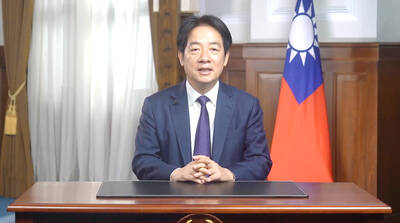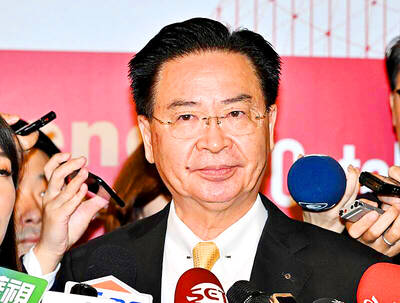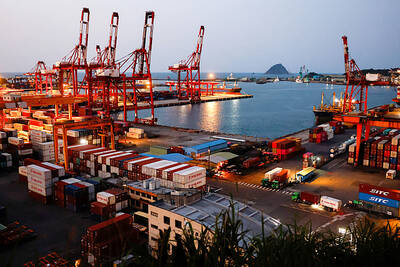The recent incident at the Third Nuclear Power Plant (核三廠) in Pingtung County has caused high-ranking officials, including Premier Chang Chun-hsiung (張俊雄), to question the care taken by Taiwan Power Company (Taipower, 台電) at the nation's nuclear plants.
While no less than four separate groups from Taipower, the Atomic Energy Council (AEC) and the Cabinet search for answers, the premier lashed out at Taipower, saying that the company has a responsibility to the lives and property of Taiwan's 23 million citizens.
As the nation closely watches the investigation into Taiwan's worst-ever nuclear mishap, environmental activists are whispering about a separate, unexposed incident at another nuclear plant which might well have led to a far more dangerous conclusion.
Unexposed incident
On March 2, workers installing fuel rod assemblies into one of the two reactors at the First Nuclear Power Plant (
At the time, the plant had stopped operation for routine maintenance. Operators must replace one fourth of the more than 400 fuel rod assemblies in the boiling water reactor (沸水式反應爐) every 18 months.
Both the reactor and the fuel rod assemblies are supplied by a General Electric (GE) plant in North Carolina.
Sources said that one of the fuel rod assemblies, which had just been shipped to Taiwan from the GE plant, was damaged after it collided with part of the water pool in which the fuel rod assemblies sit.
Sources said that workers had installed all the fuel rods and were about to start the reactor when someone noticed the damaged rod assembly and abruptly stopped the process.
Anti-nuclear activists told the Taipei Times that if workers had started the reactor under such a delicate situation, it might well have caused the reactor to malfunction.
"A damaged fuel rod assembly might create difficulties ... for inserting the control rods into the reactor to control heat production," Shih Shin-min (施信民), chairman of the Taiwan Environmental Protection Union (TEPU), told the Taipei Times.
Control rods are placed in the water pool with the fuel rod assemblies in order to control the rate of the nuclear reaction, to prevent the fuel rods from getting so hot that they melt down.
"The accident reveals a lack of attention to detail," said Shih, who also teaches chemical engineering at National Taiwan University.
Taipower's supervising body, the Atomic Energy Council (AEC), however, said the mishap was not a big deal.
"The mistake was only a minor problem [with moving the fuel rod assemblies], which is far from any so-called accident," Shen Li (
After receiving Taipower's report, the AEC immediately began an investigation into the March 2 incident.
Shen confirmed that the cause of the problem was a collision of the fuel rod assemblies when they hit part of the water pool during maintenance.
"Workers removed the damaged one immediately and replaced it with a new one," Shen said, adding that all the fuel rod assemblies now installed in the reactor were in an acceptable condition.
However, Shen said that the plant has experienced similar problems in the past.
According to Shen, the AEC had considered replacing the plant's old transportation machinery and cranes and providing more thorough training for workers in order to avoid similar situations from occurring in the future.
Lin Li-fu (
"Humans are [only] human. Mistakes are inevitable," said Lin, adding that fuel rod assemblies are sometimes bumped while being moved at nuclear plants all over the world.
"Controlling fuel rod assemblies, which are submerged under some 7m of water is quite a challenge," Lin explained.
Using damaged fuel rod assemblies in the reactor, Lin said, was not specifically forbidden, but the risks involved in doing so must first be calculated.
"Such an evaluation ... takes time and may be turned into an issue with the media," Lin said. He speculated that Taipower chose to replace the damaged fuel rod assembly rather than wait for the AEC's evaluation.
Lin stressed that the plant's safety was no longer a cause for concern as the damaged fuel rod assembly had been replaced.
Actividts' doubts
Anti-nuclear activists, however, said that the plant operators should have earlier on identified the risk involved with using a damaged fuel rod in the reactor.
"We are greatly dissatisfied that Taipower hid the truth from the public," said Tsai Sen (
Tsai, who lives near Taiwan's oldest nuclear plant, said he has twice inquired about the incident with the plant's public relations office, but has received no answer thus far.
"They said that the mistake was not a problem at all, but did not explain why not," Tsai said.
Local residents said that since the plant began operating in 1978, they've never been made aware of the causes of accidents which have occurred because Taipower has been unwilling to reveal the truth. Instead, their only knowledge of the incidents has come from piecing together news reports.
According to TEPU, in September 1999, a truck carrying 31 barrels of radioactive waste crashed into a river flowing through the plant area.
In May 1997, an electricity generator stopped because depleted fuel rod assemblies had not been replaced.
In August 1995, electrical systems at the plant were shut down as a result of a lightning storm.
In January 1992, a series of human errors and mechanical failures led to a reactor shutdown.
In March 1991, air unexpectedly entered one of the reactors, causing high levels of radiation inside major steam pipes. Operators immediately brought the reactor offline.
In August 1990, a typhoon caused a transmission line to malfunction, forcing one of the reactors offline.
In October 1988, manufacturing flaws in a water pipe caused the leakage of radioactive waste water.
Each of the these incidents pale in comparison to a 56-day period between Sept. 3 and Oct. 28, 1985 when steam jet air ejectors detected that abnormally high levels of radioactive contamination were being emitted from a reactor, exposing both employees and the public. At the time, however, no one was told to evacuate. Daily work reports during that period of time have also mysteriously disappeared.
Activists said that Taipower's 22 years of experience in running nuclear power plants did not necessarily ensure the public's safety.
"Based on recent incidents which have occurred at the First Nuclear Power Plant and the Third Nuclear Power Plant, nuclear safety issues in Taiwan still lack transparency," said Lai Wei-chieh (
Lai claimed the monitoring network established by local residents, rescue teams and fire departments did not function adequately during the recent fire at the Third Nuclear Power Plant because Taipower officials at the plant procrastinated for at least an hour before reporting the accident.
AEC officials said that the council would supervise Taipower in carrying out safety checks at the first and second nuclear power plants in Taipei County.
"We will especially focus on the condition of transmission lines at the two plants as they were the cause of the recent incident at the Third Nuclear Power Plant," said the AEC's Shen.

US President Donald Trump yesterday announced sweeping "reciprocal tariffs" on US trading partners, including a 32 percent tax on goods from Taiwan that is set to take effect on Wednesday. At a Rose Garden event, Trump declared a 10 percent baseline tax on imports from all countries, with the White House saying it would take effect on Saturday. Countries with larger trade surpluses with the US would face higher duties beginning on Wednesday, including Taiwan (32 percent), China (34 percent), Japan (24 percent), South Korea (25 percent), Vietnam (46 percent) and Thailand (36 percent). Canada and Mexico, the two largest US trading

ACTION PLAN: Taiwan would expand procurement from the US and encourage more companies to invest in the US to deepen bilateral cooperation, Lai said The government would not impose reciprocal tariffs in retaliation against US levies, President William Lai (賴清德) said yesterday, as he announced five strategies to address the issue, including pledging to increase Taiwanese companies’ investments in the US. Lai has in the past few days met with administrative and national security officials, as well as representatives from various industries, to explore countermeasures after US President Donald Trump on Wednesday last week announced a 32 percent duty on Taiwanese imports. In a video released yesterday evening, Lai said that Taiwan would not retaliate against the US with higher tariffs and Taiwanese companies’ commitments to

‘SPECIAL CHANNEL’: Taipei’s most important tasks are to stabilize industries affected by Trump’s trade tariffs and keep negotiations with Washington open, a source said National Security Council Secretary-General Joseph Wu (吳釗燮) arrived in the US for talks with US President Donald Trump’s administration, a source familiar with the matter said on Friday. Wu was leading a delegation for a meeting known as the “special channel,” the Financial Times reported earlier. It marked Trump’s first use of the channel since returning to the White House on Jan. 20. Citing a source familiar with the matter, the Financial Times reported that Minister of Foreign Affairs Lin Chia-lung (林佳龍) was also a part of the delegation. The visit came days after China concluded war games around Taiwan and amid Trump’s

CHIP EXCEPTION: An official said that an exception for Taiwanese semiconductors would have a limited effect, as most are packaged in third nations before being sold The Executive Yuan yesterday decried US President Donald Trump’s 32 percent tariff on Taiwanese goods announced hours earlier as “unfair,” saying it would lodge a representation with Washington. The Cabinet in a statement described the pledged US tariffs, expected to take effect on Wednesday next week, as “deeply unreasonable” and “highly regrettable.” Cabinet spokeswoman Michelle Lee (李慧芝) said that the government would “lodge a solemn representation” with the US Trade Representative and continue negotiating with Washington to “ensure the interests of our nation and industries.” Trump at a news conference in Washington on Wednesday announced a 10 percent baseline tariff on most goods